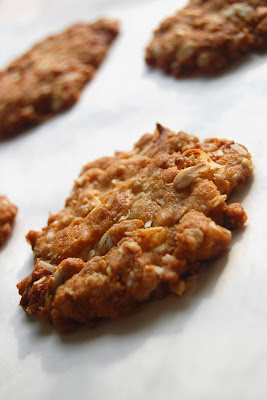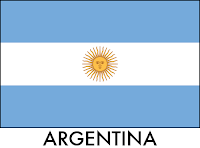 Warm wishes on ANZAC Day for all of my good friends in the antipodes. Your service is not forgotten. Here's an authentic recipe from one of my friends from Perth.
Warm wishes on ANZAC Day for all of my good friends in the antipodes. Your service is not forgotten. Here's an authentic recipe from one of my friends from Perth.
* * *

I keep an eye on holidays that aren't part of the usual US calendar. I noticed that
ANZAC Day was approaching on April 25, a holiday that I knew mostly because of the little cookies (more properly,
biscuits) that show up in grocery stores each April. ANZAC stands for
Australian and
New
Zealand
Army
Corps and the day began as a memorial for soldiers who served in WWI, though today it covers a general remembrance for veterans from the two countries. It's a very important and solemn day, marked by traditional
Dawn Services.
I was thinking about the holiday, my relatives who served alongside troops from AU/NZ in the world wars, and the myriad connections that America continues to hold with members of the Commonwealth. I also thought about the incredible wines that I've tried from Down Under, and how lucky I am to be able to enjoy them in peacetime, with clear shipping lanes between our continents.
And lastly, I thought about the biscuits.
The
store-bought ones are tasty, but homemade is always best. I Googled around for some authentic recipes for ANZAC biscuits and began to get concerned. After all, if someone wanted a great BBQ sauce recipe, the internet might direct them to some perverted source in Texas or Kansas, surely a travesty against all that is good and holy in this world.
So I e-mailed Jane Cleary, my contact in Western Australia who has sent me many interesting wine samples through
The Country Vintner. I asked her advice, and within an hour she called up her 93-year old grandmother and retrieved the family recipe. With her permission and my deep gratitude, I reprint it here, only slightly modified for American cooking units and spelling:
 Nanna's ANZAC Bikkie Recipe
Nanna's ANZAC Bikkie Recipe
1 cup rolled oats
1 cup plain flour
⅔ cups sugar
¾ cup dried coconut flakes
2 tablespoons golden syrup*
1 stick butter
1 teaspoon baking soda
2 tablespoons hot water
"Preheat oven to 320°F. Mix the oats, flour, sugar and coconut in a bowl. Place the golden syrup and butter in a saucepan over low heat and melt. Mix the baking soda with the water and add to the butter mixture. Add to the dry ingredients and mix well. Sample some of the mixture (go on--it is so hard to resist!) Place tablespoons of the mixture, leaving space between each one for spreading, onto baking trays lined with non-stick baking paper and flatten to about 3 inches in diameter. Bake for 8-10 minutes or until a deep brown. Cool on trays for 5 minutes, then transfer to wire racks to cool."

Now, as longtime readers know, I don't have a sweet tooth, and I almost never write about desserts here. But it doesn't mean that I don't know how to make them. I'm actually pretty good at making cookies, and used my air-flow baking sheets lined with parchment paper. It's just that I don't often find myself in need of several dozen bourbon-pecan-chocolate cookies.
Let's get back to the ANZAC biscuits... Utterly delicious. Great balance of the butter, coconut, sugars, and oats. Next time I might even add a few crystals of sea salt on top just to play against that caramelized sugar flavor. A lot of cookie recipes require a dollop on the cookie sheet that will flatten over time, but these do need to be pressed into roughly the size and shape of the finished product, with just a little room left for expansion. These are fun to make, particularly with the heating of the butter and syrup, which negates the need for mixers. In fact, the brilliance of this recipe is that it relies almost entirely on dried ingredients that ship well--butter is the only perishable, and there's no chocolate that might melt. Butter/margarine/shortening/lard can last for a good while at room temperature and could probably be scrounged up somewhere, while traditional cookie ingredients like eggs or milk require fresher sources.
It's also worth noting that once baked, these cookies could survive a long, unrefrigerated sea voyage from the ports of Sydney and Auckland to the fields of Verdun and Gallipoli, a welcome treat for brave lads thrown into a war far from home.

*Note:
Lyle's Golden Syrup is like a very light molasses (more properly a treacle) without any bitterness and with a luscious butterscotch flavor. You can substitute corn syrup or honey if absolutely necessary, but it won't have the purely authentic flavor... er, flavour. Lyle's invented the process and is the most popular producer. Founded in 1883, it has held a Royal Warrant to supply the British royal family since 1911. This stuff is tasty. I want to pour it on cornbread and distill rum from it.
The can and lid are the same style as wood varnish, and the logo is perhaps one of the ugliest in the world, depicting a
lion corpse surrounded by bees. It's a Biblical reference, check out the link for more details. Also, I've heard this is really difficult to find in many parts of the US, so you can
order it online if you like.
 2013 Villa Maria Cellar Selection Sauvignon Blanc
2013 Villa Maria Cellar Selection Sauvignon Blanc




























